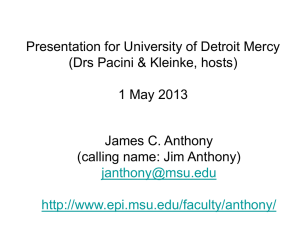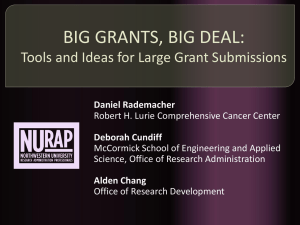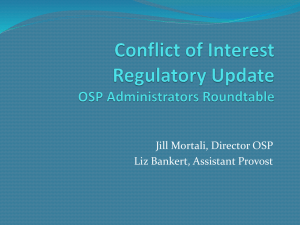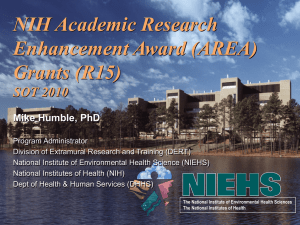( AREA ) Grants - Richard Stockton College of New Jersey
advertisement
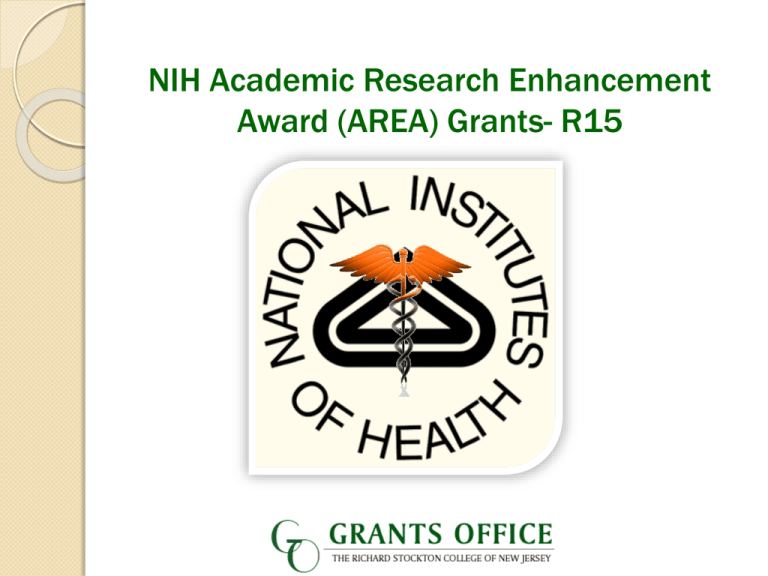
NIH Academic Research Enhancement Award (AREA) Grants- R15 The Myth of NIH funding Myth: The large government agencies like NIH do not fund small institutions or primarily undergraduate institutions (PUIs). Reality: NIH has made commitments to supporting research at institutions like PUIs or institutions with little to no NIH support. ◦ NIH’s Academic Research Enhancement Award (AREA) dedicated to this purpose. What AREA grants support AREA grants support small research projects in the biomedical and behavioral sciences conducted by faculty and students in health professional schools, and other academic components that have not been major recipients of NIH research grant funds. http://grants.nih.gov/grants/funding/area.htm NIH AREA Program Goals & Stockton AREA • To support meritorious research • To strengthen the research environment of the institution • To expose students to research Stockton 2020 Student, Faculty and Stakeholder Objective S1 Deliver high value-added learning experiences and promote scholarly activity. http://grants.nih.gov/grants/funding/area.htm What AREA grants support Pilot projects Feasibility studies Development, testing, and refinement of research techniques Secondary analysis of available data sets Other small-scale, new or ongoing healthrelated research projects AREA program research topics of particular interest to each Institute/Center can be found at: http://grants.nih.gov/grants/funding/area_grant_objectives.htm Eligibility for NIH AREA (R15) Health professional schools/colleges ◦ Public health ◦ Nursing ◦ Allied health (e.g., Physical Therapy, Occupational Therapy, Speech Pathology & Audiology) Other academic components ◦ Biology ◦ Biochemistry & Molecular Biology ◦ Psychology $6M per year limit of NIH funding (in 4 of last 7 years) per entity where the PD/PI has an appointment R15 Submission Dates ◦ Standard application deadlines: February 25 June 25 October 25 ◦ AIDS-related research deadlines: January 7 May 7 September 7 AREA Success Rates Number of Number of Fiscal Year NIH Institutes/Centers Applications Applications Success Rate2 Total Funding3 Reviewed Awarded 2009 NIA- Aging 28 7 25% $1,217,819 2009 NIAID-Allergy & Infectious Disease 93 23 25% $4,618,326 NIAMS-Arthritis & 2009 Musculoskeletal & Skin Diseases 24 5 21% $1,072,290 NCCAM-Complementary and 2009 Alternative Medicine 13 2 15% $427,282 2009 NCI-Cancer 97 27 28% $5,701,093 2009 NIDA-Drug Abuse 18 3 17% $652,193 NIDCD-Deafness & 2009 Communication Disorders 15 4 27% $835,644 NIDDK-Diabetes and Digestive 2009 and Kidney Diseases 39 6 15% $1,302,839 NIEHS-Environmental Health 2009 Sciences 25 4 16% $878,199 NICHD-Child Health & 2009 Development 91 13 14% $2,820,959 2009 NHLBI-Heart, Lung, & Blood 45 15 33% $3,218,488 2009 NIMH-Mental Health 25 5 20% $1,048,500 2009 NINR-Nursing Research 29 5 17% $1,103,974 NINDS-Neurology Disorders & 2009 Stroke 45 11 24% $2,387,570 2009 FY TOTAL 805 178 22% $37,299,776 NIH RePORTER Go to the NIH RePORTER website to query abstracts for awarded institutions and projects. Be sure to complete the Activity Code by selecting “R15 AREA” to isolate only AREA abstracts to your results. You can also refine search to specific institutes/centers or put a keyword into the term search field. NIH RePORTER: Sample Search R15 Fast Facts Application downloaded from grants.gov PI will need registration in eRA Commons ◦ Contact GO Office to set up Commons account If submitting 2/25, earliest start date Dec. Direct cost limit- $300k (does not include F&A/indirects) Project duration- 1-3 years Research Strategy section limit: 12 pages Cost-share is not required Letter of Intent is not required Research Plan Specific Aims is limited to 1 page. Research Strategy, including tables, graphs, figures, diagrams, and charts, is limited to 12 pages. Given the reduction in page limit from 24 to 12, PI will likely have to reduce the amount of space devoted to the methodology. ◦ Helpful Tip: Take advantage of the new feature of the Biographical Sketch called the Personal Statement. Briefly describe why your experience and qualifications make you particularly well-suited for your role (e.g., PD/PI, mentor, participating faculty) in the project that is the subject of the application. Sample available here: http://grants.nih.gov/grants/funding/424/index.htm#format Research Plan: Specific Aims State concisely the goals of the proposed research and summarize the expected outcome(s), including the impact that the results of the proposed research will exert on the research field(s) involved. List succinctly the specific objectives of the research proposed, e.g., to test a stated hypothesis, create a novel design, solve a specific problem, challenge an existing paradigm or clinical practice, address a critical barrier to progress in the field, or develop new technology. The Grants Office can provide a sample. Research Plan: Research Strategy The Research Strategy is organized to discuss the following aspects of the proposed project: Significance Innovation Approach Other Project Information: Project Summary Project Summary (Abstract) Succinct and accurate description of the proposed work when separated from the application. State the application’s broad, long-term objectives and specific aims, making reference to the health relatedness of the project. Describe concisely the research design and methods for achieving the stated goals. This section must be no longer than 30 lines of text. See handout for project summary samples from funded projects. Other Project Information: Project Narrative Project Narrative Using no more than two or three sentences, describe the relevance of this research to public health. In this section, be succinct and use plain language that can be understood by a general, lay audience. See handout for project narrative samples from funded projects. Other Project Information: Facilities and Other Resources • The Grants Office can offer support by providing some boiler plate information about the Stockton facilities and resources and can assist in preparing this section. • Identify the facilities to be used and indicate their capacities, pertinent capabilities, relative proximity and extent of availability to the project. • Discuss ways in which the proposed studies will benefit from unique features of the scientific environment or subject populations or will employ useful collaborative arrangements. •Multiple performance sites- describe the resources available at each site. Other Project Information: Facilities & Other Resources AREA Impact Statement This is an extra narrative section in which you describe the environment for research and undergraduate mentorship on Stockton’s campus and in the academic department. This section comes right after the Facilities & Resources section and does not count against the Research Plan page limit. A good Impact Statement includes both institutional context and project specific, discipline specific details. Should be 3-5 pages The Grants Office can provide a sample and can assist in preparing the Impact Statement. Other Project Information: Facilities & Other Resources AREA Impact Statement A profile of the students of the school/academic component and any information or estimate of the number who have obtained the baccalaureate degree and gone on to obtain an academic or professional doctoral degree in the health-related sciences during the last five years; A description of the special characteristics of the school/academic component that make it appropriate for an AREA award A description of the likely IMPACT of an AREA award on the principal investigator and the school/academic component. How will the AREA award strengthen the research environment of the school/academic component? How will the AREA award expose students to research? A statement of institutional support for the proposed research project (e.g., release time, other support, matching funds, etc.). Senior/Key Person Profile Each PD/PI must be registered in the eRA Commons. Contact the Grants Office to register! Provide a biographical sketch for all key Personnel. Recommended info includes: Education and Training, Research and Professional Experience, Collaborators and Affiliations, Publications and Synergistic Activities Biosketch template NIH R15 Submission Resources Program Announcement Application Guide Scientific & Grants Mgmt contacts by Institute Review Criteria Additional Resources & Tips New Investigator Series Articles Open Discussion/Questions? Grants Office Contact Information F-218 P.O. Box 195 Pomona, NJ 08240 Phone: (609) 652-4844 Fax: (609) 626-3467 grants@stockton.edu www.stockton.edu/grantsoffice

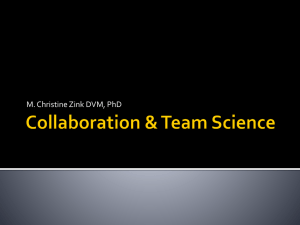
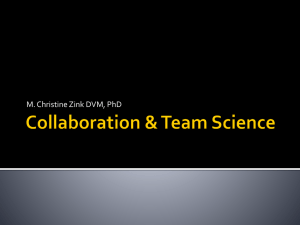

![NIH 101: Part 1 [.ppt]](http://s2.studylib.net/store/data/005398706_1-cbe361c448786ac362a8e75ad39fc05d-300x300.png)
